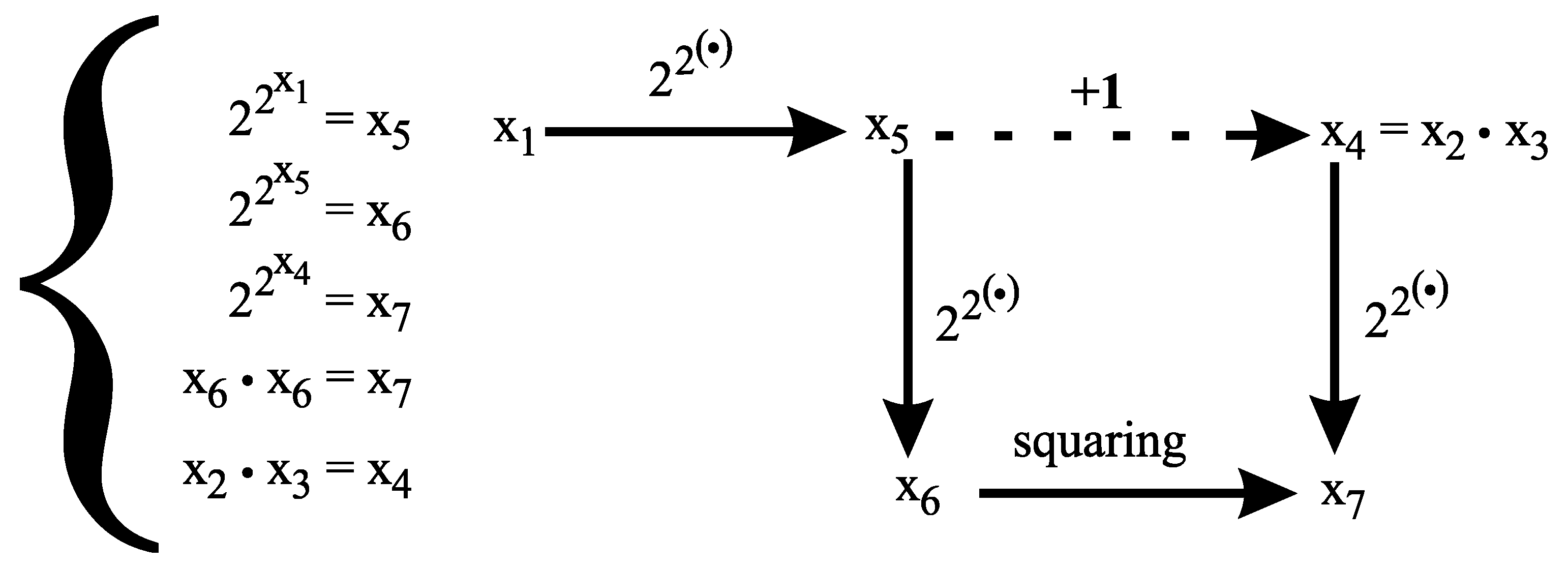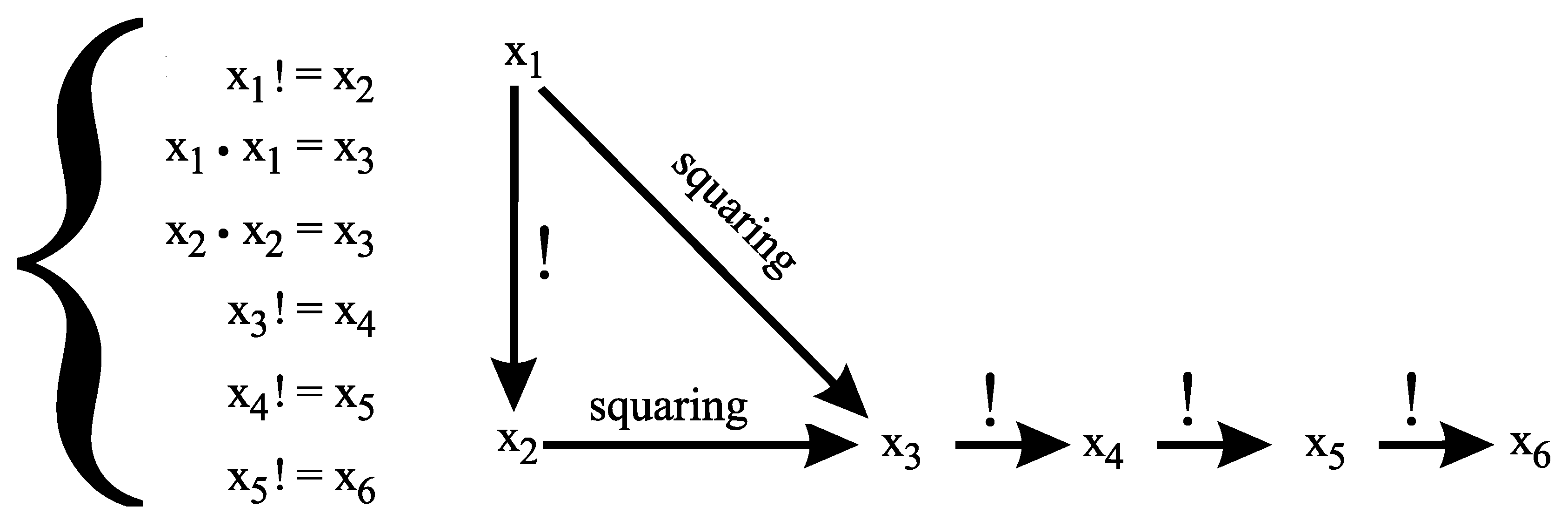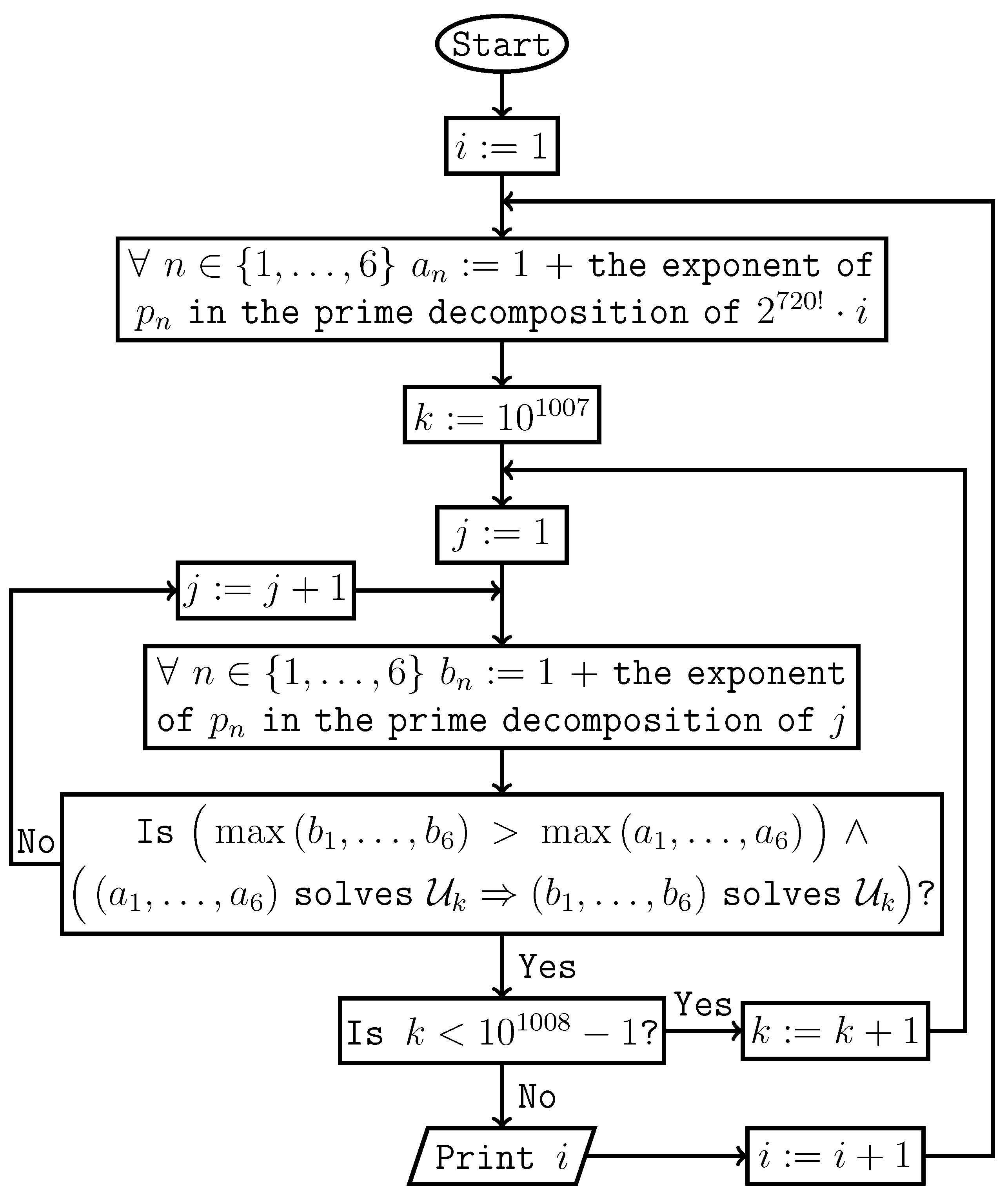1. Composite Numbers of the Form
Let
denote the following system of equations:
The following subsystem of
has exactly one solution in , namely .
Hypothesis 1. If a system of equations has at most five equations and at most finitely many solutions in , then each such solution satisfies .
Lemma 1.
([7] (p. 109) ). For every non-negative integers x and y, if and only if .
Theorem 1. Hypothesis 1 implies that is composite for infinitely many integers greater than 1.
Proof. Assume, on the contrary, that Hypothesis 1 holds and
is composite for at most finitely many integers
greater than 1. Then, the equation
has at most finitely many solutions in
. By Lemma 1, in positive integers greater than 1, the following subsystem of
has at most finitely many solutions in
and expresses that
Since , we get a contradiction. □
Most mathematicians believe that
is composite for every integer
, see [
2] (p. 23).
Open Problem 1. ([
3] (p. 159)).
Are there infinitely many composite numbers of the form ? Primes of the form
are called Fermat primes, as Fermat conjectured that every integer of the form
is prime, see [
3] (p. 1). Fermat remarked that
,
,
,
, and
are all prime, see [
3] (p. 1).
Open Problem 2. ([
3] (p. 158)).
Are there infinitely many prime numbers of the form ? 2. The Brocard-Ramanujan Equation
Let
denote the following system of equations:
The following subsystem of
has exactly two solutions in positive integers, namely and .
Hypothesis 2. If a system of equations has at most finitely many solutions in positive integers , then each such solution satisfies .
Lemma 2.
For every positive integers x and y, if and only if
Theorem 2. Hypothesis 2 implies that if the equation has at most finitely many solutions in positive integers and , then each such solution belongs to the set .
Proof. The following system of equations
is a subsystem of
. By Lemma 2, in positive integers, the system
expresses that
or
If the equation has at most finitely many solutions in positive integers and , then has at most finitely many solutions in positive integers and Hypothesis 2 implies that every tuple of positive integers that solves satisfies . Hence, . If , then is a square only for . □
It is conjectured that
is a square only for
, see [
8] (p. 297). A weak form of Szpiro’s conjecture implies that the equation
has only finitely many solutions in positive integers, see [
6].
3. Erdös’ Equation
Let
denote the following system of equations:
The following subsystem of
has exactly three solutions in positive integers, namely , , and .
Hypothesis 3. If a system of equations has at most finitely many solutions in positive integers , then each such solution ) satisfies .
Theorem 3. Hypothesis 3 implies that if the equation has at most finitely many solutions in positive integers and , then each such solution belongs to the set .
Proof. The following system of equations
is a subsystem of
. By Lemma 2, in positive integers, the system
expresses that
or
If the equation has at most finitely many solutions in positive integers and , then has at most finitely many solutions in positive integers and Hypothesis 3 implies that every tuple of positive integers that solves satisfies . Hence, . If , then is a product of two consecutive positive integers only for because the following MuPAD program
returns 2 and 3. □
The question of solving the equation
was posed by P. Erdös, see [
1]. F. Luca proved that the
conjecture implies that the equation
has only finitely many solutions in positive integers, see [
4].
4. There is No Hope for a Hypothesis that is Similar to Hypothesis 2 or 3
and Holds for an Arbitrary Number of Variables
Let , , and let for every integer . Let denote the system of equations . For an integer , let denote the following system of equations:
For every positive integer
n, the system
has exactly two solutions in positive integers
, namely
and
. For a positive integer
n, let
denote the following statement:
if a system of equations
has at most finitely many solutions in positive integers , then each such solution satisfies .
Theorem 4. Every factorial Diophantine equation can be algorithmically transformed into an equivalent system of equations of the forms and . It means that this system of equations satisfies a modified version of Lemma 4 in [7].
Proof. It follows from Lemmas 2–5 in [
7] and Lemma 2. □
The statement
is dubious. By Theorem 4, this statement implies that there is an algorithm which takes as input a factorial Diophantine equation and returns an integer which is greater than the solutions in positive integers, if these solutions form a finite set. This conclusion is strange because properties of factorial Diophantine equations are similar to properties of exponential Diophantine equations and a computable upper bound on non-negative integer solutions does not exist for exponential Diophantine equations with a finite number of solutions, see [
5].
5. There are Semi-algorithms
Such that Hypothesis j Holds if and Only if Prints Consecutive Positive
Integers Starting from 1
If
, then there are uniquely determined non-negative integers
such that
Definition 4.
For an integer , stands for the smallest system of equations satisfying conditions(1)and(2)
.
(1)If and , then the equation belongs to when it belongs to .
(2)If and , then the equation belongs to when it belongs to .
Lemma 4. .
Proof. It follows from the equality . □
For a positive integer n, let denote the n-th prime number.
Theorem 5. Hypothesis 1 holds if and only if the following semi-algorithm prints consecutive positive integers starting from 1.
Proof. It follows from Lemma 4. □
If
, then there are uniquely determined non-negative integers
such that
Definition 5.
For an integer , stands for the smallest system of equations satisfying conditions(3)and(4)
.
(3)If and , then the equation belongs to when it belongs to .
(4)If and , then the equation belongs to when it belongs to .
Lemma 5. .
Proof. It follows from the equality . □
Definition 6.
For an integer , stands for the smallest system of equations satisfying conditions(5)and(6)
.
(5)If and , then the equation belongs to when it belongs to .
(6)If and , then the equation belongs to when it belongs to .
Lemma 6. .
Proof. It follows from the equality . □
Theorem 6. Hypothesis 2 holds if and only if the following semi-algorithm prints consecutive positive integers starting from 1.
Proof. It follows from Lemma 5. □
Theorem 7. Hypothesis 3 holds if and only if the following semi-algorithm prints consecutive positive integers starting from 1.
Proof. It follows from Lemma 6. □
References
- D. Berend and J. E. Harmse, On polynomial-factorial Diophantine equations, Trans. Amer. Math. Soc. 358 (2006), no. 4, 1741–1779.
- J.-M. De Koninck and F. Luca, Analytic number theory: Exploring the anatomy of integers, American Mathematical Society, Providence, RI, 2012.
- M. Křížek, F. Luca, L. Somer, 17 lectures on Fermat numbers: From number theory to geometry, Springer, New York, 2001.
- F. Luca, The Diophantine equation P(x)=n! and a result of M. Overholt, Glas. Mat. Ser. III 37 (57) (2002), no. 2, 269–273.
- Yu. Matiyasevich, Existence of noneffectivizable estimates in the theory of exponential Diophantine equations, J. Sov. Math. vol. 8, no. 3, 1977, 299–311. [CrossRef]
- M. Overholt, The Diophantine equation n!+1=m2, Bull. London Math. Soc. 25 (1993), no. 2, 104.
- A. Tyszka, A hypothetical upper bound on the heights of the solutions of a Diophantine equation with a finite number of solutions, Open Comput. Sci. 8 (2018), no. 1, 109–114. [CrossRef]
- E. W. Weisstein, CRC Concise Encyclopedia of Mathematics, 2nd ed., Chapman & Hall/CRC, Boca Raton, FL, 2002.
|
Disclaimer/Publisher’s Note: The statements, opinions and data contained in all publications are solely those of the individual author(s) and contributor(s) and not of MDPI and/or the editor(s). MDPI and/or the editor(s) disclaim responsibility for any injury to people or property resulting from any ideas, methods, instructions or products referred to in the content. |
© 2023 by the authors. Licensee MDPI, Basel, Switzerland. This article is an open access article distributed under the terms and conditions of the Creative Commons Attribution (CC BY) license (http://creativecommons.org/licenses/by/4.0/).














